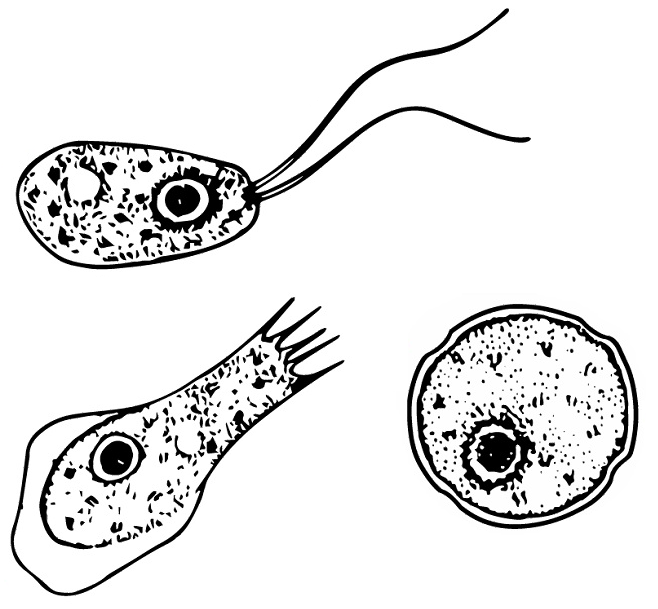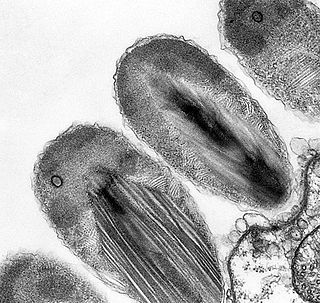Related Research Articles

The Percolozoa are a group of colourless, non-photosynthetic Excavata, including many that can transform between amoeboid, flagellate, and cyst stages.

Quail is a collective name for several genera of mid-sized birds generally placed in the order Galliformes.

The Lagomorphs are the members of the taxonomic order Lagomorpha, of which there are two living families: the Leporidae and the Ochotonidae (pikas). The name of the order is derived from the Ancient Greek lagos + morphē. There are 102 extant species of lagomorph, including 37 species of pika, 33 species of rabbit and cottontail, and 32 species of hare.
Family is one of the eight major hierarchical taxonomic ranks in Linnaean taxonomy; it is classified between order and genus. A family may be divided into subfamilies, which are intermediate ranks between the ranks of family and genus. The official family names are Latin in origin; however, popular names are often used: for example, walnut trees and hickory trees belong to the family Juglandaceae, but that family is commonly referred to as being the "walnut family".

The Gruiformes are an order containing a considerable number of living and extinct bird families, with a widespread geographical diversity. Gruiform means "crane-like".

The Noctilucales are an order of marine dinoflagellates. They differ from most others in that the mature cell is diploid and its nucleus does not show a dinokaryotic organization. They show gametic meiosis.

Anseriformes is an order of birds that comprise about 180 living species in three families: Anhimidae, Anseranatidae, and Anatidae, the largest family, which includes over 170 species of waterfowl, among them the ducks, geese, and swans. Most modern species in the order are highly adapted for an aquatic existence at the water surface. With the exception of screamers, males have penises, a trait that has been lost in the Neoaves. Due to their aquatic nature, most species are web-footed.

Laridae is a family of seabirds in the order Charadriiformes that includes the gulls, terns and skimmers. It includes around 100 species arranged into 22 genera. They are an adaptable group of mostly aerial birds found worldwide.

The frogmouths are a group of nocturnal birds related to the nightjars. They are found from the Indian Subcontinent across Southeast Asia to Australia.

Suidae is a family of artiodactyl mammals which are commonly called pigs, hogs or boars. In addition to numerous fossil species, 18 extant species are currently recognized, classified into between four and eight genera. Within this family, the genus Sus includes the domestic pig, Sus scrofa domesticus or Sus domesticus, and many species of wild pig from Europe to the Pacific. Other genera include babirusas and warthogs. All suids, or swine, are native to the Old World, ranging from Asia to Europe and Africa.

The phylum Bacteroidetes is composed of three large classes of Gram-negative, nonsporeforming, anaerobic or aerobic, and rod-shaped bacteria that are widely distributed in the environment, including in soil, sediments, and sea water, as well as in the guts and on the skin of animals.

Verrucomicrobia is a phylum of bacteria that contains only a few described species. The species identified have been isolated from fresh water, marine and soil environments and human faeces. A number of as-yet uncultivated species have been identified in association with eukaryotic hosts including extrusive explosive ectosymbionts of protists and endosymbionts of nematodes residing in their gametes.
The abbreviation cf. is used in writing to refer the reader to other material to make a comparison with the topic being discussed. Style guides recommend that cf. be used only to suggest a comparison, and the word see be used to point to a source of information.

Eustigmatophytes are a small group of eukaryotic algae that includes marine, freshwater and soil-living species.
The Banksias, by Celia Rosser, is a three-volume series of monographs containing paintings of every Banksia species. Its publication represented the first time such a large genus had been entirely painted by a single botanical artist. It has been described as "one of the outstanding botanical works of this century."

The genus Cathartes includes medium-sized to large carrion-feeding birds in the New World vulture (Cathartidae) family. The three extant species currently classified in this genus occur widely in the Americas. There is one extinct species known from the Quaternary of Cuba.

In biological classification, taxonomic rank is the relative level of a group of organisms in a taxonomic hierarchy. Examples of taxonomic ranks are species, genus, family, order, class, phylum, kingdom, domain, etc.
The Chloroflexi or Chlorobacteria are a phylum of bacteria containing isolates with a diversity of phenotypes, including members that are aerobic thermophiles, which use oxygen and grow well in high temperatures; anoxygenic phototrophs, which use light for photosynthesis ; and anaerobic halorespirers, which uses halogenated organics as electron acceptors.

The Rhytismatales are an order of the class Leotiomycetes within the phylum Ascomycota.
Holotheria are a diverse group of mammals that are descendants of the last common ancestor of Kuehneotherium and Theria.
References
- ↑ Lumbsch TH, Huhndorf SM. (December 2007). "Outline of Ascomycota – 2007". Myconet. Chicago, USA: The Field Museum, Department of Botany. 13: 1–58. Archived from the original on 2009-03-18.